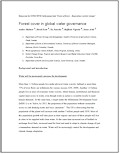| Book Chapter |
 |
|
| Title | Forest cover in global water governance | | Author | Anders Malmer, Jonas Ardo, David Scott, Raffaele Vignola and Xu Jianchu | | Editors | Gerardo Mery, Pia Katila, Glenn Galloway, René I. Alfaro, Markku Kanninen, Maxim Lobovikov and Jari Varjo | | Year | 2010 | | Book Title | Future of forests – Responding to global changes | | Publisher | International Union of Forest Research Organizations (IUFRO) | | City of Publication | China | | Pages | 1-32 | | Call Number | BC0302-10 | | Keywords | trees, water quality, water supply, water use, flood control, green water, PES,
REDD, drought, climate change, modeling | | Notes | ISBN: 978-3-901347-93-1, ISSN: 1016-3263 |
|
| Abstract: |
| Globally, water is recognised as a key resource for growing cities and to
sustainably increase production of food and energy under threat from climate chance.
There is also increasing recognition of the need for more sustainable and transparent
management of water resources. Trees and forests, be they cultivated more or less
intensively or natural forests in various degrees of degradation and fragmentation, have a central role in water cycling and for protecting water quality. This chapter reviews the role and function of forests in water cycling and management, but also how this knowledge and/or beliefs affect policies and governance of forests with regard to
water management. The main objective is to develop a common understanding of the
basis of the role of forest management in water governance and a readiness for the
diversity of scenarios in a global change perspective on these issues. The chapter gives
a short review of the biophysical understanding of forest and water relationships, and
also how this leads to different perceptions and policies on the ecological services, or
benefits, that forests provide. Perceptions of such benefits are dependent on a number
of factors, including what characteristics of water quality or quantity are desired,
and also what are the different dependencies and perceptions of the values provided
by the forests themselves, apart from their effects on water resources. In relation to
this, descriptions of current and developing governance systems, such as “payment for
environmental services” are given. In conjunction, the strong link between the role
of trees in soil and water management, and the increasing role of forests for carbon
sequestration and climate change adaptation are discussed. Major conclusions include
emphasis on preparedness for solutions where forest management is part of water
governance in landscape perspectives to meet the needs of many different land users.
In this sense, we emphasise that general policies cannot meet sound forest and water
governance, but locally/regionally based models and scenarios need to be used as the
basis for governance systems. In many parts of the developing world, this puts demand
on more empirical data as well as national capacities for research and governance,
including transparency and local involvement of stakeholders. |
|
|
Download file(s): Click icon to download/open file.
|
| |
File Size |
Description |

|
1,022 KB |
Softcopy |
|
|
GRP 5: Improving the ability of farmers, ecosystems & governments to cope with climate change
|
| Viewed in 2708 times. Downloaded in 161 times. |